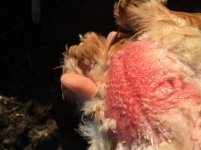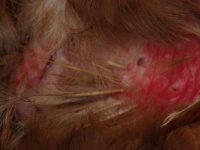Poor girl, she does look rather uncomfortable, doesn't she?
You can see feathers coming through in pin, which is hopeful, and the red colouring could be a response to being naked in the cold winter weather. If the vet didn't see any evidence of infestation, then maybe the most likely explanation is what they're eating and their living conditions. Hybrids are specially bred to keep going on laying eggs throughout at least their first 18 months of life, after which egg production does begin to drop off, so a farmer will then cull them and get younger ones. But they can only do this out of doors through the winter if they have the sort of diet which keeps their energy up, and are kept in conditions which give them some shelter from wind and rain. Chickens are hardy outdoor birds, and purebreds have largely adapted to outdoor life in exposed runs in winter by shutting down egg laying and using the time and energy to replace their feathers, when necessary. Hybrids are usually bred to be farmed indoors, where it's warm and dry, and so it takes more of their energy to keep warm out of doors, but they still try to keep going on egg laying. If they don't have the right quality of food, they can't keep their feathers in good shape as well as producing eggs. This may account for the fact that your hardier Sussex girls are unaffected by the feather loss, and it's only the hybrids who are naked.
If they were mine, I would change their pellets to a recommended brand, well-known for its high quality. That means Dodson and Horrell, Smallholders, or Garvo, possibly Marriages (although they produce two grades of layers pellets, one of these is the Economy brand, and it would be best to get the other, better-quality type.) Then I would equip their run with two large plates supported off the ground on blocks, so they don't eat off the muddy ground where there may be worm eggs, and would mix a warm damp mash every day from pellets and a few high-protein treats such as sunflower seeds etc. I would get some Nettex Mineral supplement powder and mix this into the mash, as if you feed it on dry pellets it doesn't stick to them - thats why you need a mash. Don't think about changing to game bird mix, these hybrids have to have layers pellets as they need the high levels of calcium to support eggshell quality. A good brand will have all the other minerals and vitamins that laying hens need, and the Nettex powder will give them the extra boost of minerals and probiotics they require to return to full health and feathering. Go easy on the cider vinegar - if you use too strong a mix it will make them reluctant to drink, and this will be very harmful to them. Personally I never use the stuff, my hens don't like it, they would choose plain water when offered two drinkers, one with, one without.
Free ranging in the garden would be good, so long as it's safe from predators such as foxes. The other thing I would do is to fix willow screening round three sides of the end of the run where the feed is kept, using cable ties to fix it to the mesh. I've found it's easy to attach, makes a good windbreak, and will provide filtered shade in summer as well. I understand you can't do much about roofing such a large run, but if you could give them an area at the sheltered end where they could get out of the wind and rain, they would use less energy keeping warm and dry. You recently posted about muddy conditions - were you able to do anything about this? with any sort of skin condition, a big dustbath under cover and nice and dry would be very helpful. In north Yorkshire, you must get the worst the winter can throw at them, and comfortable conditions would help them a lot.
Then just sit back and wait for the days to get longer and warmer, and hopefully the feathers will grow back and egg production will increase.


